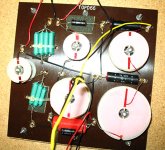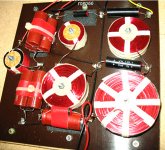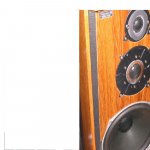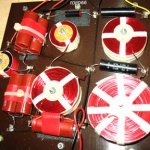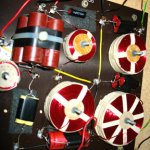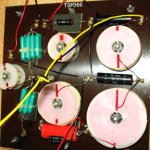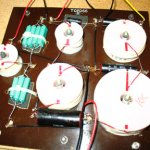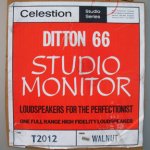Hi,
I only had time to test 2 of my speakers for DC resistance. Both pairs of 66's are in the same room...one pair on top of the other in a tower arrangement. The lower pair I'll call "blacky" because of the black front, and the upper pair I'll call "woody", for the wood front.
left woody:
high....4.4-4.5
mid....6.6-6.7
low....4.1-4.2
left blacky:
high....3.8-3.9
mid....6.7-6.8
low....4.3-4.4
...and from a spare woofer: 4.2-4.3
I only had time to test 2 of my speakers for DC resistance. Both pairs of 66's are in the same room...one pair on top of the other in a tower arrangement. The lower pair I'll call "blacky" because of the black front, and the upper pair I'll call "woody", for the wood front.
left woody:
high....4.4-4.5
mid....6.6-6.7
low....4.1-4.2
left blacky:
high....3.8-3.9
mid....6.7-6.8
low....4.3-4.4
...and from a spare woofer: 4.2-4.3
"...we add a series resistor to each polyprop. cap to simulate the ESR of the electro's so the impedances, including the phase angles, will be the same as Celestion's original, so that the drivers will cross over at the original design frequencies."
So...it seems then that replacing electro caps with polyprop ones necessitates the use of an added resistor.
Since this is my foray with crossovers, I'll sit here on the side and wait for brand, size, value, etc recommendations.
Thanks
Scott / sba
So...it seems then that replacing electro caps with polyprop ones necessitates the use of an added resistor.
Since this is my foray with crossovers, I'll sit here on the side and wait for brand, size, value, etc recommendations.
Thanks
Scott / sba
incorrect spelling
I don't know why I cannot remember how to spell some words that I have read a sufficient number of times to remember !
Correct spelling is :- absorption
This is for Dielectric Absorption, as discussed above, and which I correct here in the event readers want to research that phenomena in capacitors.
alan-1-b said:
So, why not simply use new electrolytic caps which have the higher ESRs ?
Well, electrolytic caps also have high Dielectric Absorbsion.
What is that ?
It is a Memory effect. Basically when the electro cap is charged by the signal {music} it retains part of that charge and does not fully discharge and charge to the opposite polarity when the signal changes polarity.
It does charge and discharge and re-charge etc, but always lagging the signal by a much larger time interval than the Time Constant of the circuit.
The audible consequence is a muddying of the music owing to the mixing of delayed release information being added to new information.
{this is a simplification of the full process, but it's sufficient to give you the idea}
Polypropylene caps have very very low dielectric absorbsion. That is one reason why they are so good for audio signal use.
I don't know why I cannot remember how to spell some words that I have read a sufficient number of times to remember !
Correct spelling is :- absorption
This is for Dielectric Absorption, as discussed above, and which I correct here in the event readers want to research that phenomena in capacitors.
Diffraction control
Pete, I'm pleased you have heard the effect of reducing the diffraction.
What you have reported is what I had expected would occur, and how I hear such myself.
I would also describe it as "clearer" {as distinct from "brighter" which can be caused by diffraction in some circumstances}.
If you try a strip down both front edges of the baffle panel from where-ever you have stopped in the tweeter area to down past the mid-dome a few inches, then you should be able to hear similar benefits in the mids' reproduction.
The strip will need to be at least 3" wide for the mids, as it has to absorb sufficient part of the longer wavelengths of the lower frequencies there.
Sound should be clearer with the grilles off, but if listening with the grilles on, than the tighter fit you mention should reduce vibration of the grille frame.
I am puzzled by the "ringing effect at moderate attenuation" you mentioned.
Is this when the wool is loose, or when the grille is looser fitting ?
Are you listening with those oval/rings around the tweeters still in place, or them off and only the wool on now ?
Yes, do post some pictures, as that will show us what you have done, and may help to see how to solve the ringing effect you have mentioned.
tonedef2 said:
News> I finished messing around with the diffraction problem> net result was, attaching the audio wool to the upper grill works best and did have a good affect, I will describe as less blurring of the high freq energy, note: if you listen with grills off........then I simply used a custom cut wool with very little Velcro to slip under the top over hang (your grill will fit a little tighter), works great and am now working on the aesthetics.....
2-I will post some picks of the grill soon for analysis as im pretty sure as the audio wool loosens over time we have a ringing affect at moderate attenuation.
Pete, I'm pleased you have heard the effect of reducing the diffraction.
What you have reported is what I had expected would occur, and how I hear such myself.
I would also describe it as "clearer" {as distinct from "brighter" which can be caused by diffraction in some circumstances}.
If you try a strip down both front edges of the baffle panel from where-ever you have stopped in the tweeter area to down past the mid-dome a few inches, then you should be able to hear similar benefits in the mids' reproduction.
The strip will need to be at least 3" wide for the mids, as it has to absorb sufficient part of the longer wavelengths of the lower frequencies there.
Sound should be clearer with the grilles off, but if listening with the grilles on, than the tighter fit you mention should reduce vibration of the grille frame.
I am puzzled by the "ringing effect at moderate attenuation" you mentioned.
Is this when the wool is loose, or when the grille is looser fitting ?
Are you listening with those oval/rings around the tweeters still in place, or them off and only the wool on now ?
Yes, do post some pictures, as that will show us what you have done, and may help to see how to solve the ringing effect you have mentioned.
the DC resistances, and the large orange-red capacitors.
Great stuff sba !
thankyou indeed for posting the DCR's , as this confirms the figures Pete has posted also for those, and the two different vintage samples are of interest also.
Is your "blackie" 66s older than your "woodie" set ?
There may be a Date, or some type of Date Code printed on either the front or back of the cross-over boards.
Capacitor C7 - the parallel pair of large orange + small black is probably a 20uF electrolytic cap {orange} with the black cap the same 4uF type as C5 on one of Grahame's set of boards.
The large red-orange caps in the treble filter section of "blackie's" board I do not recognise, but possibly these are a Paper-in-oil capacitor type, as such were used in cross-overs years ago, and are said to give better sound than Electrolytics and some plastic types.
Can you read what is printed on them, and post here ?
I may be able to identify them from the lettering.
Some paper-in-oil types do not have as high dielectric absorption as electrolytics, but this depends on the type of material{s} used to make the paper, and the type of oil.
Main problem of paper-in-oil types over period of time is they develop leakage, and especially if heated.
Heating is less likely in a speaker x-over than in a tube amplifier chassis, unless the speakers have been played very loud for long periods, but as yours are quite old do look closely around all joins in their coatings, ends of and around the wire holes for any sign of a substance leaking.
There is also Electrical Leakage - of charge. That is a different phenomena and occurs to some degree in all capacitors, but less so in well made ones, but is to some degree dependant on type of capacitor.
Pete, you know more about the vintages/versions of the Ditton 66 than I do.
Those two sba has seem to be older types than Grahame's pair, and yours - {if yours are the same as Grahame's ?}, ?
"woodie's" board has the two sets of old type plastic film caps in the treble filter the same as on those 2 boards that Grahame bought from the e-bay seller.
Notice that the DCR of the tweeter in "blackie" is lower than in "woodie" and in Pete's later model 66.
I wonder if this is simply co-incidence, as we only know 1 tweeter sample from "blackie", OR, if Celestion changed the voice-coil in a later version of their HF2000 tweeter ...
What-ever the case, and I do not know for sure but I think paper-in-oil caps have larger ESRs than even those old plastic caps, thus the ESR of the paper-in-oil cap may be sufficient to add to the DCR of that lower DCR tweeter to give effectively the same resistance at the 5 kHz cross-over frequency as the higher DCR tweeter + very low DCR of the plastic film caps ...
More on this when I post about capacitor selections, soon I hope .
Great stuff sba !
thankyou indeed for posting the DCR's , as this confirms the figures Pete has posted also for those, and the two different vintage samples are of interest also.
Is your "blackie" 66s older than your "woodie" set ?
There may be a Date, or some type of Date Code printed on either the front or back of the cross-over boards.
Capacitor C7 - the parallel pair of large orange + small black is probably a 20uF electrolytic cap {orange} with the black cap the same 4uF type as C5 on one of Grahame's set of boards.
The large red-orange caps in the treble filter section of "blackie's" board I do not recognise, but possibly these are a Paper-in-oil capacitor type, as such were used in cross-overs years ago, and are said to give better sound than Electrolytics and some plastic types.
Can you read what is printed on them, and post here ?
I may be able to identify them from the lettering.
Some paper-in-oil types do not have as high dielectric absorption as electrolytics, but this depends on the type of material{s} used to make the paper, and the type of oil.
Main problem of paper-in-oil types over period of time is they develop leakage, and especially if heated.
Heating is less likely in a speaker x-over than in a tube amplifier chassis, unless the speakers have been played very loud for long periods, but as yours are quite old do look closely around all joins in their coatings, ends of and around the wire holes for any sign of a substance leaking.
There is also Electrical Leakage - of charge. That is a different phenomena and occurs to some degree in all capacitors, but less so in well made ones, but is to some degree dependant on type of capacitor.
Pete, you know more about the vintages/versions of the Ditton 66 than I do.
Those two sba has seem to be older types than Grahame's pair, and yours - {if yours are the same as Grahame's ?}, ?
"woodie's" board has the two sets of old type plastic film caps in the treble filter the same as on those 2 boards that Grahame bought from the e-bay seller.
Notice that the DCR of the tweeter in "blackie" is lower than in "woodie" and in Pete's later model 66.
I wonder if this is simply co-incidence, as we only know 1 tweeter sample from "blackie", OR, if Celestion changed the voice-coil in a later version of their HF2000 tweeter ...
What-ever the case, and I do not know for sure but I think paper-in-oil caps have larger ESRs than even those old plastic caps, thus the ESR of the paper-in-oil cap may be sufficient to add to the DCR of that lower DCR tweeter to give effectively the same resistance at the 5 kHz cross-over frequency as the higher DCR tweeter + very low DCR of the plastic film caps ...
More on this when I post about capacitor selections, soon I hope .
I'm back - sorry for the gap.
Alan - thanks for your very informative posts. I hope you haven't been affected by the recent flooding in the UK.
sba - welcome to our little gathering. Quad 66's - now that must sound impressive!
Interesting that Celestion seemed to go through so many crossover styles. Continuous improvement, or whatever they had in the parts bin /the supplier delivered- who knows?
sba - good to see that your crossover has the zip-tied green capacitors - I wasn't certain if they were originals on the crossovers I won on ebay - but this would seem to indicate they were.
One side effect of all this measurement is that I noticed that one of the MD-500s was cutting out intermittently - traced it down to the red/black wires on the outside must have been pinched at some point in all this opening / closing of the cases and would make / brake if you wiggled the wire . Solution - solder another wire in parallel from the connection on the back of the front plate to the tab at the base of the case - seems to have done the trick. Did it on both sides to be sure.
With all this assembling /disassembling are there any better solutions for semi - permanent connections that the rather flimsy seeming tab / folded spade arrangement ? Anything mil-spec designed for the task or better more modern solutions - or am I just being fussy? I could solder it in place + then just use the new form of connection where required.
Ok, now onto DC Resistance - which is where it gets interesting ... or not.
LEFT Speaker
HF2000 (high) = 4.6
MD500 (mid) = 6.6
12"(low) = 4.2
RIGHT speaker
HF2000 (high) = 9.2
MD500 (mid) = 6.8
12"(low) = 4.2
Should I be concerned in the difference in R for the HF2000's ?
Any possible causes? any significance in the fact the values differ by a factor of 2?
To these cloth ears there doesn't appear to a gross difference -in fact they still sound fine to me - given that their placement is not ideal due to room / WAF constraints
I'm hoping to get some objective frequency response plots - so I can see if there is a difference, and what form it takes - if any.
tonedef2 - look forward to your pictures - then I can try the same thing at this end.
Glad to be back,
Grahame.
P.S. if there are any other 66 owners lurking please speak up - the more the merrier - especially as I've noticed quite a few pop up ebay.co.uk - pity they all seem to be buyer collects
Alan - thanks for your very informative posts. I hope you haven't been affected by the recent flooding in the UK.
sba - welcome to our little gathering. Quad 66's - now that must sound impressive!
Interesting that Celestion seemed to go through so many crossover styles. Continuous improvement, or whatever they had in the parts bin /the supplier delivered- who knows?
sba - good to see that your crossover has the zip-tied green capacitors - I wasn't certain if they were originals on the crossovers I won on ebay - but this would seem to indicate they were.
One side effect of all this measurement is that I noticed that one of the MD-500s was cutting out intermittently - traced it down to the red/black wires on the outside must have been pinched at some point in all this opening / closing of the cases and would make / brake if you wiggled the wire . Solution - solder another wire in parallel from the connection on the back of the front plate to the tab at the base of the case - seems to have done the trick. Did it on both sides to be sure.
With all this assembling /disassembling are there any better solutions for semi - permanent connections that the rather flimsy seeming tab / folded spade arrangement ? Anything mil-spec designed for the task or better more modern solutions - or am I just being fussy? I could solder it in place + then just use the new form of connection where required.
Ok, now onto DC Resistance - which is where it gets interesting ... or not.
LEFT Speaker
HF2000 (high) = 4.6
MD500 (mid) = 6.6
12"(low) = 4.2
RIGHT speaker
HF2000 (high) = 9.2
MD500 (mid) = 6.8
12"(low) = 4.2
Should I be concerned in the difference in R for the HF2000's ?
Any possible causes? any significance in the fact the values differ by a factor of 2?
To these cloth ears there doesn't appear to a gross difference -in fact they still sound fine to me - given that their placement is not ideal due to room / WAF constraints
I'm hoping to get some objective frequency response plots - so I can see if there is a difference, and what form it takes - if any.
tonedef2 - look forward to your pictures - then I can try the same thing at this end.
Glad to be back,
Grahame.
P.S. if there are any other 66 owners lurking please speak up - the more the merrier - especially as I've noticed quite a few pop up ebay.co.uk - pity they all seem to be buyer collects
Hello,
Have read the new posts and will respond soon in more detail......that 9. DCR on the HF2000 of Graham's may be a problem when taking his measurements? Alan? No time, more later...
Ringing/vibrating due to the grill cloth/wool (i think it's wool?)loosening over time on the metal frame, more later...
Where making good progress gentlemen....
ToneDef2/Pete
Have read the new posts and will respond soon in more detail......that 9. DCR on the HF2000 of Graham's may be a problem when taking his measurements? Alan? No time, more later...
Ringing/vibrating due to the grill cloth/wool (i think it's wool?)loosening over time on the metal frame, more later...
Where making good progress gentlemen....
ToneDef2/Pete
Hello all,
Just saw this sale conclude on eBay.
http://cgi.ebay.com/ws/eBayISAPI.dll?ViewItem&rd=1&item=110153227729&ssPageName=STRK:MEWA:IT&ih=001
1 of 12
Supersize
Sold for: US $1,149.99
Auction ended early with Buy It Now.
Ended: Jul-29-07 07:21:13 PDT
Shipping costs: To United States -- US $245.00Expedited Int'l Flat Rate ShippingService to United States(more services)
Ships to: Worldwide
Item location: Ottawa, ON, Canada
History: 3 bids
Buyer: jdefe99 ( private )
You can also: Email to a friend
Listing and payment details: Show
Starting time: Jul-26-07 20:15:00 PDT
Starting bid: US $9.99
Payment methods: PayPal
See details
Meet the seller
Seller: foku123 ( 372 )
Feedback: 100% Positive
Member: since May-21-04 in Canada
Read feedback comments
Ask seller a question
Add to Favorite Sellers
View seller's other items
Contact the seller instantly
Buy safely
1. Check the seller's reputation
Score: 372 | 100% PositiveRead feedback comments
2. Check how you're protected
Up to $2,000 in buyer protection. See eligibility
Description
Item Specifics - Home Speakers
Speaker Type: Floor Standing Wireless: --
Brand: Celestion Condition: Used
Cabinet Color: Wood - Light
This translation is provided as a service. eBay cannot guarantee its accuracy. View Item Specifics in original language.
Near MINT!!! & Upgraded CELESTION Ditton 66 Studio Monitor Speakers - ZERO FEEDBACK BIDDERS ARE WELCOMED - AUCTION IS NOT OPEN TO INTERNATIONAL BIDDERS DUE TO SIZE & WEIGHT. BUT IF YOU NEED DRIVERS ONLY- YOU CAN BID - WE HAVE 30-DAY ON-HOLD PROGRAMME – SEE BELOW FOR DETAILS - BID ON OUR ITEMS WITH FULL CONFIDENCE : WE TAKE RESPONSIBILITIES IF ITEMS ARE LOST OR DAMAGED DURING SHIPPING Hi! – You are bidding on well maintained beautiful pair of Celestion Ditton 66 Studio Monitor. They are in perfect shape as expected by audiophiles and Celestion lovers. The speakers are in excellent condition. All drivers are original with rubber surrounds. The cabs are almost MINT. The have the original metal grilles with newer grille cloths. The original owner looked after them like his babies. He added four feet with each speaker to keep even the bottom part free from scratches and they worked well as spikes. All logos are present. Very hard to find in this condition. You won’t be disappointed with the performance and look.
Just saw this sale conclude on eBay.
http://cgi.ebay.com/ws/eBayISAPI.dll?ViewItem&rd=1&item=110153227729&ssPageName=STRK:MEWA:IT&ih=001
1 of 12
Supersize
Sold for: US $1,149.99
Auction ended early with Buy It Now.
Ended: Jul-29-07 07:21:13 PDT
Shipping costs: To United States -- US $245.00Expedited Int'l Flat Rate ShippingService to United States(more services)
Ships to: Worldwide
Item location: Ottawa, ON, Canada
History: 3 bids
Buyer: jdefe99 ( private )
You can also: Email to a friend
Listing and payment details: Show
Starting time: Jul-26-07 20:15:00 PDT
Starting bid: US $9.99
Payment methods: PayPal
See details
Meet the seller
Seller: foku123 ( 372 )
Feedback: 100% Positive
Member: since May-21-04 in Canada
Read feedback comments
Ask seller a question
Add to Favorite Sellers
View seller's other items
Contact the seller instantly
Buy safely
1. Check the seller's reputation
Score: 372 | 100% PositiveRead feedback comments
2. Check how you're protected
Up to $2,000 in buyer protection. See eligibility
Description
Item Specifics - Home Speakers
Speaker Type: Floor Standing Wireless: --
Brand: Celestion Condition: Used
Cabinet Color: Wood - Light
This translation is provided as a service. eBay cannot guarantee its accuracy. View Item Specifics in original language.
Near MINT!!! & Upgraded CELESTION Ditton 66 Studio Monitor Speakers - ZERO FEEDBACK BIDDERS ARE WELCOMED - AUCTION IS NOT OPEN TO INTERNATIONAL BIDDERS DUE TO SIZE & WEIGHT. BUT IF YOU NEED DRIVERS ONLY- YOU CAN BID - WE HAVE 30-DAY ON-HOLD PROGRAMME – SEE BELOW FOR DETAILS - BID ON OUR ITEMS WITH FULL CONFIDENCE : WE TAKE RESPONSIBILITIES IF ITEMS ARE LOST OR DAMAGED DURING SHIPPING Hi! – You are bidding on well maintained beautiful pair of Celestion Ditton 66 Studio Monitor. They are in perfect shape as expected by audiophiles and Celestion lovers. The speakers are in excellent condition. All drivers are original with rubber surrounds. The cabs are almost MINT. The have the original metal grilles with newer grille cloths. The original owner looked after them like his babies. He added four feet with each speaker to keep even the bottom part free from scratches and they worked well as spikes. All logos are present. Very hard to find in this condition. You won’t be disappointed with the performance and look.
Hello all, welcome sba!
Alan>
1-Yes the sound is cleaner, however im-having trouble with something that may look good…Q>so Alan how thin can I go on the wool? Can you save me time trying endless thicknesses, also if you look at the front baffle, you will see that the outer router grooves that run the length of each side have 2 reflecting points as well!!!
So I will (after hearing from Alan regarding wool thickness) try and cover the entire top section for a test, if positive then the hard part of fabricating something removable, that won’t damage the wood and still accommodate grill placement can begin, L.
2-Ringing was the wrong word choice rather lower in frequency, I have tracked this down and a simple re-glue of grill cloth and fixed it, check your glue in this location folks….
3- Yes with the rings still in place as it appears I’ll need to replace the cardboard around the tweeter after removal of rings, cardboard in integral too as it’s used to hold the diaphragm in place. Alan could the simple application of 2 fairly thick and wide felted wool rings work to avoid the many reflecting & diffracting points on these baffles with the exception of the top overhang?
4-Will post with simple how-to pics when I get to the end of trial and error
5- From what I’ve seen it appears that sba’s crossovers have been swapped…..no accounting for parts availability at production time, but I’ve seen the newer green boards in the 662 and later model 66’s plus the black baffles are of earlier models with some using the MF500 mid dome. Mine are stamped late 1979, 1980 being the last year I believe.
6a- Re: Hf2000 DCR’s, my HF2000’s have brand new NOS OEM diaphragms, installed by an authorized Celestion dealer/commercial speaker repair place, he’s been doing this for 35 years….he might have a line on a replacement for Grahams…if needed.
6b-Re:HF2000’s best info says they where unchanged through all years.
Grahame>
Glad to see you back, yes I think that tweeter has seen better days, but don’t take my word for it…..
I will be more than happy to share the baffle diffraction details as soon as I get something we can live with that won’t make our 66’s look like my wool socks exploded on the front of them!!! Heh.
Sba>
Welcome to our project, how are your neighbors holding up with those “4x12in 18 Hz woofers? It seems to me like your crossovers have been switched, blackie should be sporting the older boards, hmmmm.
1500.00 for those early version 66’s on eBay! That’s nice huh :-0
Bye for now folks, Alan get back to me on the thickness question.
ToneDef2/ Pete
Alan>
1-Yes the sound is cleaner, however im-having trouble with something that may look good…Q>so Alan how thin can I go on the wool? Can you save me time trying endless thicknesses, also if you look at the front baffle, you will see that the outer router grooves that run the length of each side have 2 reflecting points as well!!!
So I will (after hearing from Alan regarding wool thickness) try and cover the entire top section for a test, if positive then the hard part of fabricating something removable, that won’t damage the wood and still accommodate grill placement can begin, L.
2-Ringing was the wrong word choice rather lower in frequency, I have tracked this down and a simple re-glue of grill cloth and fixed it, check your glue in this location folks….
3- Yes with the rings still in place as it appears I’ll need to replace the cardboard around the tweeter after removal of rings, cardboard in integral too as it’s used to hold the diaphragm in place. Alan could the simple application of 2 fairly thick and wide felted wool rings work to avoid the many reflecting & diffracting points on these baffles with the exception of the top overhang?
4-Will post with simple how-to pics when I get to the end of trial and error
5- From what I’ve seen it appears that sba’s crossovers have been swapped…..no accounting for parts availability at production time, but I’ve seen the newer green boards in the 662 and later model 66’s plus the black baffles are of earlier models with some using the MF500 mid dome. Mine are stamped late 1979, 1980 being the last year I believe.
6a- Re: Hf2000 DCR’s, my HF2000’s have brand new NOS OEM diaphragms, installed by an authorized Celestion dealer/commercial speaker repair place, he’s been doing this for 35 years….he might have a line on a replacement for Grahams…if needed.
6b-Re:HF2000’s best info says they where unchanged through all years.
Grahame>
Glad to see you back, yes I think that tweeter has seen better days, but don’t take my word for it…..
I will be more than happy to share the baffle diffraction details as soon as I get something we can live with that won’t make our 66’s look like my wool socks exploded on the front of them!!! Heh.
Sba>
Welcome to our project, how are your neighbors holding up with those “4x12in 18 Hz woofers? It seems to me like your crossovers have been switched, blackie should be sporting the older boards, hmmmm.
1500.00 for those early version 66’s on eBay! That’s nice huh :-0
Bye for now folks, Alan get back to me on the thickness question.
ToneDef2/ Pete
Hi,
"It seems to me like your crossovers have been switched, blackie should be sporting the older boards, hmmm"
tonedef2-- I think you had it right....blackie does seem to have the oldest point to point crossovers....blackie's crossover inductors lack the white plastic reels of later models (looking again at the blackie crossover pic, notice that those white radial spokes on the top side of the inductors are simply cloth tape), and Alan thinks that blackie's treble capacitors might possibly be of the older paper-in-oil type.
Alan-- I'll try to find some time later in the week to pull out blackie's board in order to look for a date, and to get info about the orange colored treble capacitors (whose info is hidden behind red colored electrical tape).
So, it seems then that the blackies are first generation 66. Mine look exactly like the pair that tonedef2 just posted from the ebay sale ($1500, wow) -- with black fronts; with beveled edges around the speaker terminal cutouts; and with metallic speaker labels surrounding (directly over) the speaker terminals. The labels also lack the word "Ditton".....It's just a "Celestion 66".
The woodies must be the next generation. Mine look exactly like Grahame's (pictured in this thread) -- with wood fronts; with 90 degree edges on the speaker terminal cutouts; with the metallic speaker label now at the top rear; and with the addition of quality control stamps and the word "Ditton" on the label. But, my pair has an older point to point crossover board with green-colored treble capacitors, while Grahame's pair has a more modern printed crossover board (until he replaced his with the same older board that I have)
And from the last generation, the 662, I saw a pair of crossovers on ebay that looked even more modern than Grahame's....in that the speaker terminals seemed to be connected directly to the back of the crossover board--so that either the crossover had been relocated to behind the ABR, or it remained behind the woofer, and the speaker terminal cutout had instead been moved towards the center.
So, does this sound right....three generations of Celestion 66 speakers, and at least four different crossover boards (two point-to-point, and two printed)?
I 'm sort of curious about the 66 date ranges. The U.S. reviews that I've seen date from around September 1977 (Stereo Review - vol 39, no 3 & High Fidelity - vol 27, no 9) This was the 66 woodie era. Maybe the 66's had a late introduction to the U.S. I wonder when production first began on the blackies. The B&O website says that the Beovox 5700--apparently using the Celestion 66 high & mid drivers (I read somewhere that the woofer, which has a differently shaped flange than the 66, was made by Goodmans)--were available from 1971 on. So the first Celestion 66's must also date from somewhere near that time.
Wouldn’t it be fun to see some retired Celestion employee from the 1970's chime in with more facts about the 66's production, because there's very little production info on this particular speaker (as well as that decade) in the history section of the company's website, or anywhere on the internet!
tonedef2-- My first pair of 66's, the woodies, came with light-colored grill cloths that were impregnated with cola and other stains. I tore off the cloths as a temporary remedy and, while procrastinating about what to do, glued the celestion emblem to the metal frames, and put those back in place. They've been like this for four years now. Have you ever seen speaker grille frames like those?...they're really a piece of work. And the highs come through a little easier without the cloth. With the blackies it wouldn't look so good though. Eventually I would like to redo all four 66s with a light colored fabric....so I'll be paying attention to your progress.
sba
"It seems to me like your crossovers have been switched, blackie should be sporting the older boards, hmmm"
tonedef2-- I think you had it right....blackie does seem to have the oldest point to point crossovers....blackie's crossover inductors lack the white plastic reels of later models (looking again at the blackie crossover pic, notice that those white radial spokes on the top side of the inductors are simply cloth tape), and Alan thinks that blackie's treble capacitors might possibly be of the older paper-in-oil type.
Alan-- I'll try to find some time later in the week to pull out blackie's board in order to look for a date, and to get info about the orange colored treble capacitors (whose info is hidden behind red colored electrical tape).
So, it seems then that the blackies are first generation 66. Mine look exactly like the pair that tonedef2 just posted from the ebay sale ($1500, wow) -- with black fronts; with beveled edges around the speaker terminal cutouts; and with metallic speaker labels surrounding (directly over) the speaker terminals. The labels also lack the word "Ditton".....It's just a "Celestion 66".
The woodies must be the next generation. Mine look exactly like Grahame's (pictured in this thread) -- with wood fronts; with 90 degree edges on the speaker terminal cutouts; with the metallic speaker label now at the top rear; and with the addition of quality control stamps and the word "Ditton" on the label. But, my pair has an older point to point crossover board with green-colored treble capacitors, while Grahame's pair has a more modern printed crossover board (until he replaced his with the same older board that I have)
And from the last generation, the 662, I saw a pair of crossovers on ebay that looked even more modern than Grahame's....in that the speaker terminals seemed to be connected directly to the back of the crossover board--so that either the crossover had been relocated to behind the ABR, or it remained behind the woofer, and the speaker terminal cutout had instead been moved towards the center.
So, does this sound right....three generations of Celestion 66 speakers, and at least four different crossover boards (two point-to-point, and two printed)?
I 'm sort of curious about the 66 date ranges. The U.S. reviews that I've seen date from around September 1977 (Stereo Review - vol 39, no 3 & High Fidelity - vol 27, no 9) This was the 66 woodie era. Maybe the 66's had a late introduction to the U.S. I wonder when production first began on the blackies. The B&O website says that the Beovox 5700--apparently using the Celestion 66 high & mid drivers (I read somewhere that the woofer, which has a differently shaped flange than the 66, was made by Goodmans)--were available from 1971 on. So the first Celestion 66's must also date from somewhere near that time.
Wouldn’t it be fun to see some retired Celestion employee from the 1970's chime in with more facts about the 66's production, because there's very little production info on this particular speaker (as well as that decade) in the history section of the company's website, or anywhere on the internet!
tonedef2-- My first pair of 66's, the woodies, came with light-colored grill cloths that were impregnated with cola and other stains. I tore off the cloths as a temporary remedy and, while procrastinating about what to do, glued the celestion emblem to the metal frames, and put those back in place. They've been like this for four years now. Have you ever seen speaker grille frames like those?...they're really a piece of work. And the highs come through a little easier without the cloth. With the blackies it wouldn't look so good though. Eventually I would like to redo all four 66s with a light colored fabric....so I'll be paying attention to your progress.
sba
Sba >
I think your correct about the boards with one exception, the 662’s where a different type of studio monitor attempt, I believe they paralleled the 66 version 2 chronologically, and it’s unclear if they caught on (in studio’s) and very little is said about them. They are very different, bass tuning, mid driver and crossover too. The 66 versions 2 were widely used in studios, as well as 66 v 1’s. My thought is the tried to tighten the bass and near field ability as I’ve noticed the best distance from the 66’s is 10 to 15 feet away.
Yes that was a nice high price for those 66’s on eBay, I did email the guy regarding the upgrades etc, and very little was done or checked!
The 66 grills all came in black wool, reinforced with plastic thread (best I can tell), the 662’s came in that medium brown color.
40 years almost since the Celestion folks worked on these….would be fun to here from one, these Celestions are one of those lost gems in audio, and it’s my experience that you would need to through 10,000 away to best them and I have heard some that don’t compare at that price, something about how these where tuned by hear that I like very much and such is the same for pursuit of the Green Backs and other pro models etc.
Here's an idea, email the fellow that bought the 662 xovers and see if he can contribute some specs, there may be a Celestion improvement to be had in the bass area, all though I really like the bass tone with the spikes in place…
As soon as we hear from Alan we should have a very nice recipe for a large improvement of the upper registers.
Little pic of a restored MD500...
TonDef2
I think your correct about the boards with one exception, the 662’s where a different type of studio monitor attempt, I believe they paralleled the 66 version 2 chronologically, and it’s unclear if they caught on (in studio’s) and very little is said about them. They are very different, bass tuning, mid driver and crossover too. The 66 versions 2 were widely used in studios, as well as 66 v 1’s. My thought is the tried to tighten the bass and near field ability as I’ve noticed the best distance from the 66’s is 10 to 15 feet away.
Yes that was a nice high price for those 66’s on eBay, I did email the guy regarding the upgrades etc, and very little was done or checked!
The 66 grills all came in black wool, reinforced with plastic thread (best I can tell), the 662’s came in that medium brown color.
40 years almost since the Celestion folks worked on these….would be fun to here from one, these Celestions are one of those lost gems in audio, and it’s my experience that you would need to through 10,000 away to best them and I have heard some that don’t compare at that price, something about how these where tuned by hear that I like very much and such is the same for pursuit of the Green Backs and other pro models etc.
Here's an idea, email the fellow that bought the 662 xovers and see if he can contribute some specs, there may be a Celestion improvement to be had in the bass area, all though I really like the bass tone with the spikes in place…
As soon as we hear from Alan we should have a very nice recipe for a large improvement of the upper registers.
Little pic of a restored MD500...
TonDef2
Attachments
Hi all,
Here are the DCR's from all of my Celestion 66's:
*************************
Blackies -- 1st generation 66's -- serial #s 00249 and 00344
------#00249---------#00344
high---3.8-3.9---------4.9-5.0
mid----6.7-6.8---------6.8-6.9
low----4.3-4.4---------4.1-4.2
**************************
Woodies -- 2nd generation 66's -- serial #s 013259 and 27343
------#013259 -----------#27343
high---- 4.4-4.5-------------4.3-4.4
mid -----6.6-6.7-------------6.3-6.4
low-----4.1-4.2--------------4.3-4.4
**************************
Now....the interesting part. No crossover board is completely identical to any of the others. Blackie #344 contains capacitors that are different than Blackie #249 (pictured above in post #84).
The treble section in Blackie #344 contains two small yellow-colored capacitors that read
ARCO 1.05
2.2 / 10
100 v
and (common to both blackies) four large, dark red-colored, bakelite covered capacitors that read
A 316
Metallised
1.5 pf 150v
D.C. WKG
73 / 25
These A316s were wrapped with electrical tape and had a plastic zip tie around them. After cutting the zip tie and removing the tape, I noticed that the thick bakelite coating on these was cracked all over....in fact, a piece fell off in my hand--exposing the inside metal..... No turning back now....looks like I'm in this project till the end....LOL
Additionally, over in the sub section, Blackie #344 twice uses three capacitors where Blackie #249 uses only one.
*********************************
The two woodie crossovers are almost alike except that one of them, #27343, lacks the small capacitor mounted with the larger one at the bottom of the board.
Confusing...huh!
sba
Here are the DCR's from all of my Celestion 66's:
*************************
Blackies -- 1st generation 66's -- serial #s 00249 and 00344
------#00249---------#00344
high---3.8-3.9---------4.9-5.0
mid----6.7-6.8---------6.8-6.9
low----4.3-4.4---------4.1-4.2
**************************
Woodies -- 2nd generation 66's -- serial #s 013259 and 27343
------#013259 -----------#27343
high---- 4.4-4.5-------------4.3-4.4
mid -----6.6-6.7-------------6.3-6.4
low-----4.1-4.2--------------4.3-4.4
**************************
Now....the interesting part. No crossover board is completely identical to any of the others. Blackie #344 contains capacitors that are different than Blackie #249 (pictured above in post #84).
The treble section in Blackie #344 contains two small yellow-colored capacitors that read
ARCO 1.05
2.2 / 10
100 v
and (common to both blackies) four large, dark red-colored, bakelite covered capacitors that read
A 316
Metallised
1.5 pf 150v
D.C. WKG
73 / 25
These A316s were wrapped with electrical tape and had a plastic zip tie around them. After cutting the zip tie and removing the tape, I noticed that the thick bakelite coating on these was cracked all over....in fact, a piece fell off in my hand--exposing the inside metal..... No turning back now....looks like I'm in this project till the end....LOL
Additionally, over in the sub section, Blackie #344 twice uses three capacitors where Blackie #249 uses only one.
*********************************
The two woodie crossovers are almost alike except that one of them, #27343, lacks the small capacitor mounted with the larger one at the bottom of the board.
Confusing...huh!
sba
- Status
- This old topic is closed. If you want to reopen this topic, contact a moderator using the "Report Post" button.
- Home
- Loudspeakers
- Multi-Way
- Celestion 66 needs mid-range
